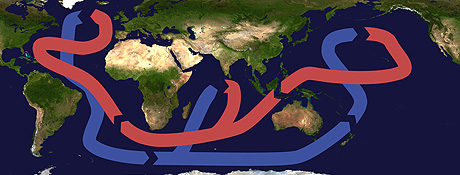Climate Change: Atlantic Ocean Circulation More Stable Than Believed
15 December 2014
International research team studies current and its impact on earth’s climate

Photo: Brisbane, CC BY-SA 3.0
The circulation of the Atlantic ocean, which has a major impact on the earth’s climate, is more stable than once thought. This was shown in studies by an international research team, including members from Heidelberg University. The researchers analysed the circulation of the deep waters of the North Atlantic over the past 140,000 years and were able to demonstrate that the current “warm” mode of the Atlantic’s circulation played a key role even during the earth’s last cold period, contrary to prior assumptions. According to Dr. Evelyn Böhm of the Institute of Environmental Physics, this infers that the present circulation is so stable that its collapse, e.g. from the increased melting of the Greenland ice sheet, is extremely unlikely. Therefore, a sudden and extreme drop in temperature in Europe is not to be expected. The study was published in the journal “Nature”.
“For about two million years the earth has been in a glacial age characterised by frozen polar regions and regular longer cold and shorter warm cycles”, explains Evelyn Böhm. “The time period we studied includes the last cold cycle, the end of the penultimate cold cycle, and the last two warm cycles, including the current Holocene.” Due to the redistribution of heat and carbon dioxide, ocean circulation in the Atlantic, whose pattern changes within a cold-warm cycle, has a major impact on the earth’s climate. In addition to researchers from the Institute of Environmental Physics, study participants also included scientists from the Oeschger Centre for Climate Change Research at the University of Bern, the GEOMAR Helmholtz Centre for Ocean Research Kiel and the ETH Zürich.
For their investigations, the researchers took sediment core samples 4,500 metres below sea level off the Bermudas. They were able to reconstruct the circulation pattern of the Atlantic using the temporal variations of isotope ratios. “For simplification, these patterns can be subdivided into the ‘warm’ and ‘cold’ modes. In the warm mode, water masses close to the surface at the northern latitudes sink down and then form the deep North Atlantic waters flowing south. In phases in which the circulation is in ‘cold’ mode, the water masses in the north reach a lesser depth. At the same time, Antarctic bottom waters from the south penetrate further north”, explains Dr. Jörg Lippold, formerly of Heidelberg University and now with the University of Bern.
Contrary to previous assumptions, the researchers showed that the warm mode predominated not only during warm cycles, but even during the last cold cycle. “Only at the peak of the last two cold periods did we observe the circulation pattern of the cold mode,” explains Dr. Marcus Gutjahr from GEOMAR in Kiel. “The results therefore show that the warm mode, which also matches today’s circulation pattern, is more stable than previously assumed”, adds Gutjahr’s colleague Prof. Dr. Martin Frank. According to the researchers, the large quantities of fresh water from melting ice masses cause only a brief weakening in this circulation pattern, not a complete collapse of the North Atlantic deep water accumulation. Only when the ice sheets had fully extended during the cold period peaks did such fresh water intrusions cause the deep water accumulation in the North Atlantic to collapse over several hundred years, resulting in a further drop in average temperatures in the northern hemisphere.
However, only limited conclusions on the role of humans in climate change can be drawn from the current data, according to Evelyn Böhm. “Today’s CO2 emissions represent an unprecedented encroachment in the climate system, but their effects were not part of our study,” explains the scientist.

